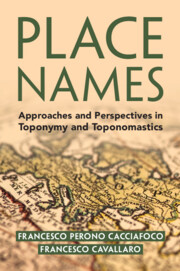Book contents
- Place Names
- Place Names
- Copyright page
- Contents
- Figures
- Tables
- Preface
- Acknowledgements
- 1 Introduction
- 2 Language Change
- 3 Historical Toponomastics
- 4 Toponymy and the Historical-Linguistic Reconstruction of Proto-Languages
- 5 Diachronic Toponymy
- 6 Landscape and Toponymy
- 7 Historical Toponomastics and Historical Geography
- 8 Synchronic Toponymy
- 9 Place Names and Society
- 10 Toponymy and Cartography
- Glossary
- References
- Index
5 - Diachronic Toponymy
Published online by Cambridge University Press: 02 March 2023
- Place Names
- Place Names
- Copyright page
- Contents
- Figures
- Tables
- Preface
- Acknowledgements
- 1 Introduction
- 2 Language Change
- 3 Historical Toponomastics
- 4 Toponymy and the Historical-Linguistic Reconstruction of Proto-Languages
- 5 Diachronic Toponymy
- 6 Landscape and Toponymy
- 7 Historical Toponomastics and Historical Geography
- 8 Synchronic Toponymy
- 9 Place Names and Society
- 10 Toponymy and Cartography
- Glossary
- References
- Index
Summary
This chapter explores the notion of diachronic toponymy, which is the discipline that deals with the reconstruction of a place name in the context of undocumented languages/language families and in the absence of historical records. In many communities that do not have a writing system, oral stories and traditions become important sources of toponymic data, as place names are passed down orally, from one generation to another. Additionally, oral stories also commemorate the land and its namers, and are an ‘oral record’ of the physical territory and the changes made to it by human inhabitation. The chapter presents a step-by-step guide for studying place names according to a diachronic toponymy approach – one that also incorporates methods from anthropological linguistics, language documentation, and field linguistics. This is applied to a toponymic system in the Abui community on Alor Island, southeast Indonesia. The authors also demonstrate how historical semantics can complement the toponymic analysis by applying its criteria to a toponymic system which includes several Abui toponyms that show a semantic specialisation of the Abui term for ‘village’.
Keywords
- Type
- Chapter
- Information
- Place NamesApproaches and Perspectives in Toponymy and Toponomastics, pp. 114 - 133Publisher: Cambridge University PressPrint publication year: 2023

